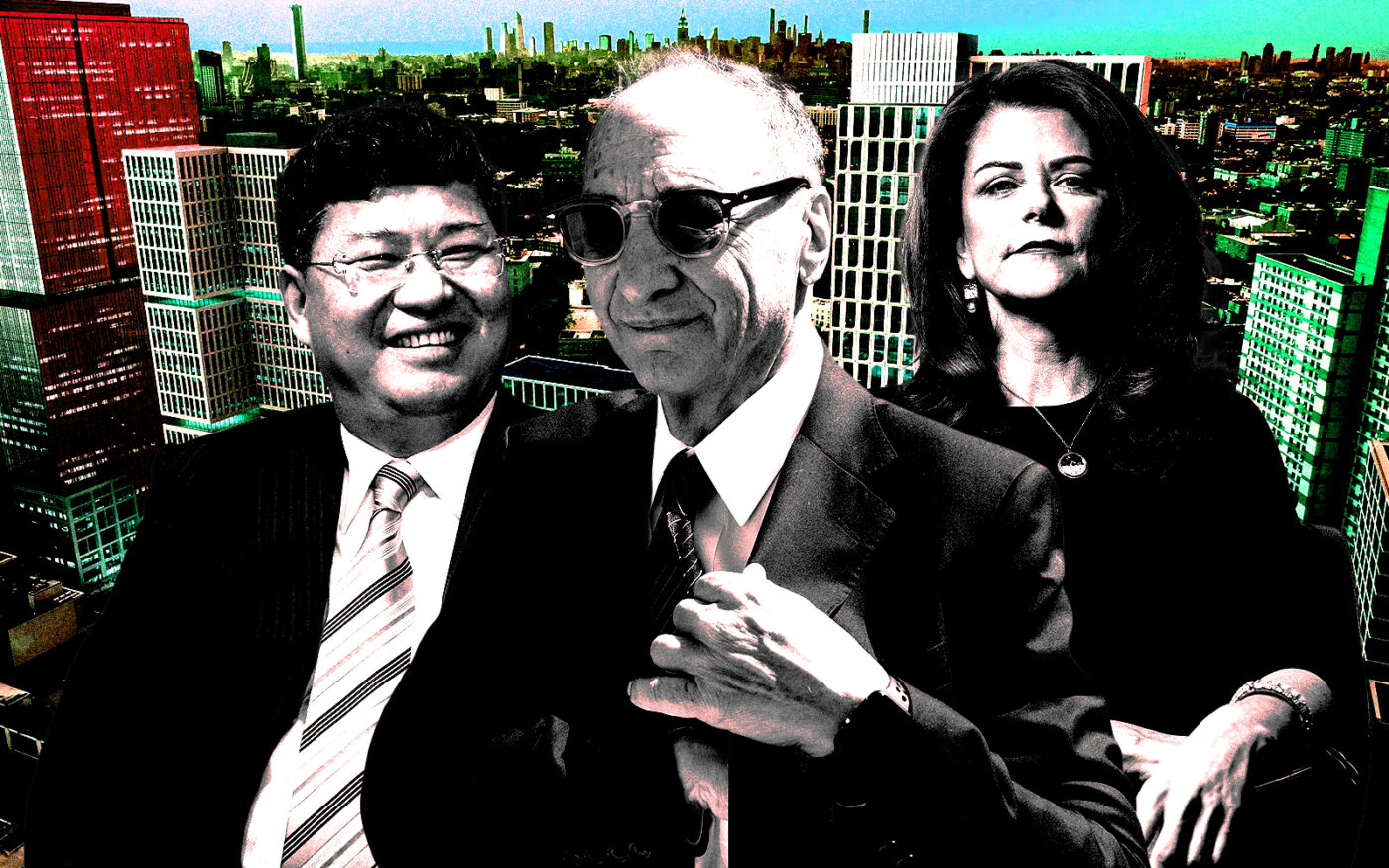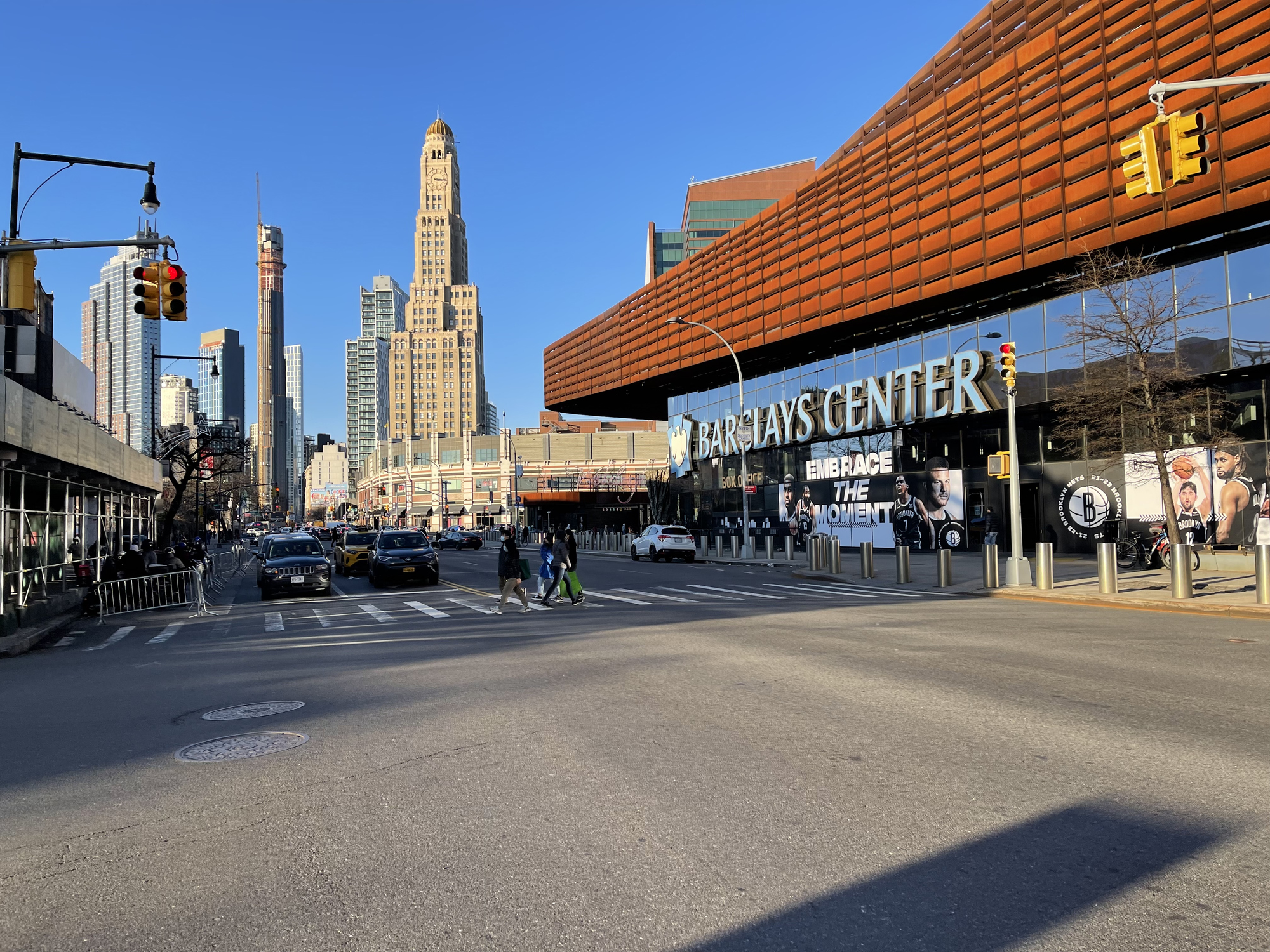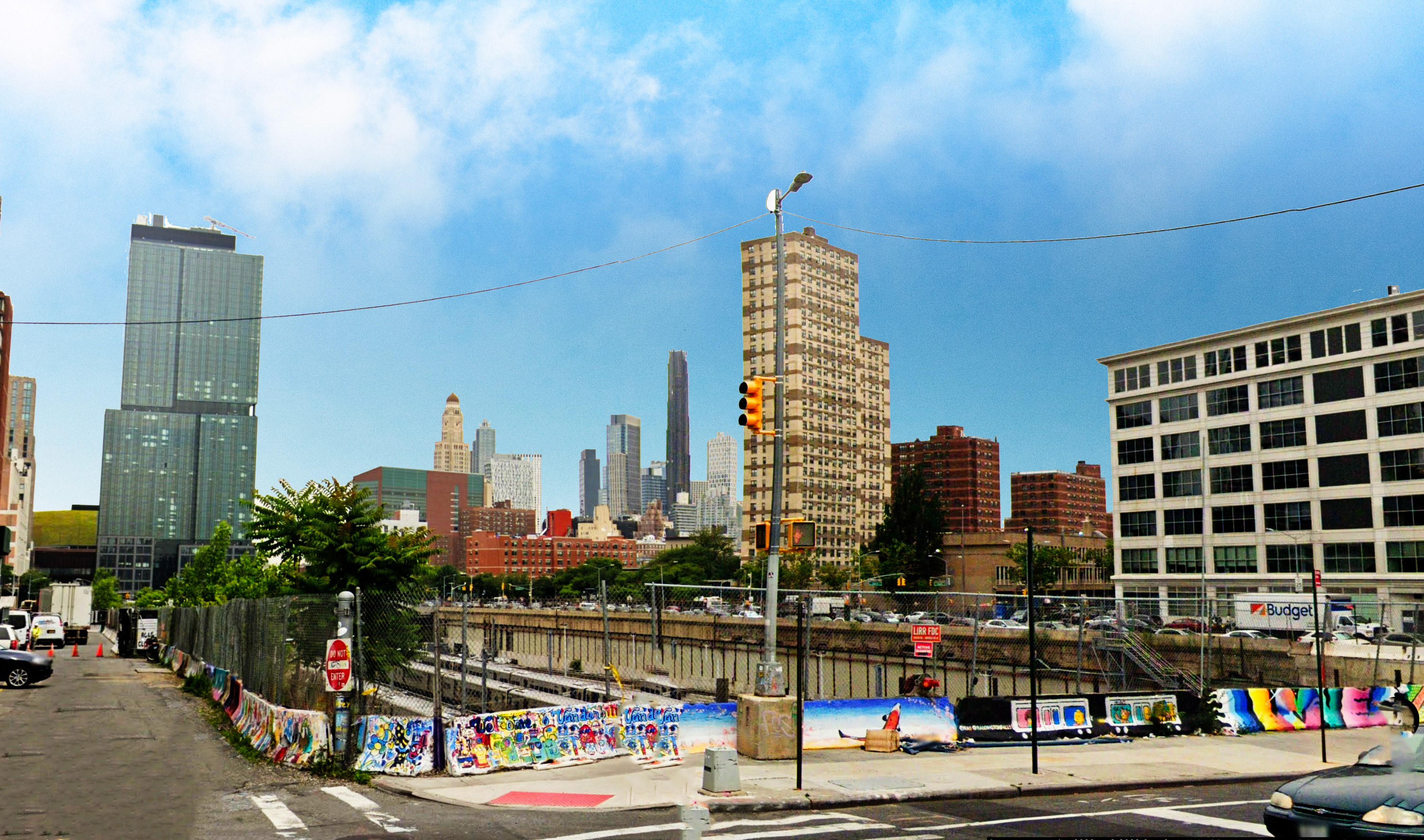Trending
Atlantic Yards at 20: Unfinished and facing foreclosure
Brooklyn’s star-crossed megaproject limps into third decade

From left: Greenland’s Zhang Yuliang, Bruce Ratner and MaryAnne Gilmartin along with a rendering of Pacific Park Brooklyn (Getty, Pacific Park Brooklyn, Greenland)
Twenty years ago to the day, a developer unveiled a $2.5 billion vision for what he hoped would be Brooklyn’s most celebrated project since its eponymous bridge opened in 1883. To mark the anniversary, however, no one cut a ribbon, posed with a shovel or even raised a toast.
Instead, the project’s lender quietly filed paperwork to begin foreclosure proceedings.
The fanfare of Atlantic Yards’ launch is a distant memory now. On Dec. 10, 2003, developer Bruce Ratner assembled a star-studded team at Brooklyn Borough Hall to drum up excitement about the project. Renowned architect Frank Gehry and Brooklyn-born stars Jay-Z and former New York Knicks forward Bernard King were on hand.
Ratner was vying to buy the New Jersey Nets and move the team to a glassy new home he would build in Prospect Heights, to be designed by Gehry. Uniquely shaped office towers and apartment buildings would rise around it, covering the rail yard from which the development was named. “The Brooklyn project will not disappoint wow-seekers,” the New York Times architecture critic wrote, oblivious to the pitfalls ahead.
Ratner’s bid for the Nets — which developer Charles Kushner and then-New Jersey Sen. John Corzine were also trying to buy — hinged on building an arena that would be bolstered by profitable office and residential components surrounding it. The rail yard had to remain active during construction, and his firm, Forest City Ratner, would have to buy out the site’s many private owners.
Ratner had developed the nearby MetroTech office complex, but Atlantic Yards was orders of magnitude more complicated. At the announcement, he sought to assure that he could get it done.
“We are real,” he said. “This is going to happen.”
Two decades later, that is looking more doubtful than ever.
A legacy of problems
Some of Ratner’s original vision has materialized. A lot hasn’t.
The arena, Barclays Center, opened in 2012, but not with Gehry’s elaborate design, which was deemed too expensive. The architect was fired as master planner of the project at-large as well. Forest City scrapped the project’s signature tower, initially dubbed Miss Brooklyn, and later bailed out of Atlantic Yards entirely, selling the development rights to Greenland USA. Ratner’s firm is now defunct, and he has disappeared from the real estate scene.

Greenland, a subsidiary of a Shanghai-based conglomerate, rebranded the project Pacific Park, sold some pieces to other developers, and is struggling to hold onto what it kept. The expected cost has doubled, to $5 billion.
From the outset, the project encountered one problem after another, with each one chipping away at its viability. Local opposition and lawsuits caused years of delays, and then the Financial Crisis hit. An attempt at modular construction went awry. Forest City Ratner dissolved, Greenland ran into headwinds in China, the pandemic came and interest rates soared.
Nine of the planned 15 buildings are complete, but the remainder of the project is in jeopardy. Greenland defaulted on $350 million worth of loans tied to six development sites. Finding builders and lenders for them is complicated by a 2014 agreement requiring 876 more affordable apartments be built by 2025. Missing the deadline — a near certainty — could trigger millions of dollars in penalties.
Current and former elected officials, as well as sources familiar with the project, have long been skeptical that Greenland could complete it, given the financial woes of its parent company in China and the cost of constructing a platform over the rail yard.
“I’d be shocked if there aren’t other developers that come in to finish the job,” one source familiar with the project said. “It’s a lot for any one company.”
The situation raises bigger questions about promises made by developers, notably whether the government will hold companies to those pledges or rescue projects with public dollars.
“There are other state-led projects that would be threatened,” said Brooklyn Borough President Antonio Reynoso. “All these commitments can be broken, because they were broken at Atlantic Yards.”
“They ran into a buzzsaw”
The megadevelopment faced immediate opposition. At the time of Ratner’s press conference, then-Council member Letitia James called it a “land grab by a powerful developer.” Community groups railed against the idea of displacing residents to remove “blight” by building an arena and towers.
Ratner bought the Nets for $300 million in 2004. Two years later, the state signed off on Forest City’s plans for the arena and at least 4,500 apartments. Empowered by eminent domain, the state planned to assemble the project sites and lease them to the developer through long-term agreements. It would override the city’s zoning — circumventing James, the local Council member — through a general project plan.
Opponents sued, accusing the developer and state of abusing eminent domain to take over 97 lots for the 22-acre project. The case hinged on whether the project site met the legal definition of “blighted.”
In the spring of 2009, the developer scaled down plans for the gleaming office tower Miss Brooklyn, swapping it for a shorter design that journalists compared to precariously stacked Jenga pieces. Citing the ligation, slowing economy and rising construction costs, Ratner dropped Gehry.
“They ran into a buzzsaw of an economic downturn,” recalled Marty Markowitz, who as Brooklyn borough president was the project’s biggest supporter.
Markowitz had seen an opportunity to bring the borough its first major sports franchise since the Dodgers left Brooklyn in 1957. (The team might have stayed, but Robert Moses refused to condemn land for a new ballpark at the site where Barclays was ultimately built.) He had prompted Ratner to buy the Nets, leading to the redevelopment plan for the rail yard — an area he saw as an abscess amid Brooklyn’s renaissance.
“You have to understand where Brooklyn was,” he said. “[The site] was a pit. It was a railroad pit.”
That was literally the case. The MTA’s Atlantic Yards is eight tracks in a deep cavity between Pacific Street and Atlantic, Carlton and Vanderbilt avenues. A chain link fence rings the sunken land.
Forest City shelled out untold millions to buy out property owners on the adjacent parcels, which included healthy if undersized co-ops, while the state pursued its eminent domain case. By November 2009, the state’s highest court had paved the way for the developer to take over homes and businesses at the site.
The following April, the final holdout, Daniel Goldstein, accepted $3 million from Forest City for his Pacific Street apartment. Most of it reportedly went to the legal bills his opposition group, Develop Don’t Destroy Brooklyn, had rung up. A month later, Ratner sold the Nets to Russian billionaire Mikhail Prokohorov.
Jay-Z christened the arena, designed by SHoP Architects, with eight sold-out shows. Ratner stepped down as Forest City’s CEO in January 2013, tapping MaryAnne Gilmartin as his successor.
She started on a high note because the traffic nightmare that opponents predicted at Flatbush, Atlantic and Fourth avenues had not happened. Gilmartin said she and others at Forest City felt “victorious” during opening week when Flatbush Avenue “didn’t sink into a traffic hole.”
“We had done the hard work of making sure the subway was designed properly, making sure the building let people out in eight minutes or less so that the communities around it didn’t suffer from a long, drawn-out entry and exit sequence for events,” she said. “So the standout thing for me is the beauty, performance, and good neighborly aspect of Barclays Center.”
Greenland agreed to buy a majority stake in the project in 2013. At the time, construction on the project’s first residential tower, B2, was underway. Gilmartin declared that Forest City “cracked the code” on modular construction with the project, but the tower was later plagued by delays, leaks and litigation between the developer and Skanska, who had teamed up to launch a prefabrication factory to supply the project. By 2016, Forest City had sold the business.
Forest City Ratner was a New York subsidiary of Cleveland-based Forest City Realty, a firm that began as a lumber outfit in the 1920s. After becoming a real estate investment trust in January 2016, the Midwestern firm retreated from ground-up development and its board reduced the Ratner family’s control over the firm.
Gilmartin left in January 2018 to start her own venture, citing Forest City’s departure from ground-up development. Brookfield purchased Forest City later that year for $11.4 billion and retired the name. It still owns a nominal stake in Pacific Park.
During a recent phone call, Gilmartin recalled that Forest City made public commitments “upfront that were long-lasting, far-reaching, formidable obligations” that further complicated the project.
“We front-loaded a lot of the equity, and it didn’t produce revenue and a return for a very, very long time,” she added.
Greenland’s grief
Bringing professional sports and an arena to Brooklyn were selling points for the project, but what made it politically possible was its promise of affordable housing. Its opponents warned that Forest City would try to get out of it and felt validated in 2009 when the developer, citing the Financial Crisis, got the project’s 10-year timeline extended to 2035.
In 2014, just before closing its deal with Greenland, Forest City reached a settlement with the city and community groups to complete the project’s 2,250 affordable apartments by 2025. The new mayor, Bill de Blasio, agreed to kick in subsidies — in the case of a 298-unit building at 535 Carlton Avenue, $40,000 per unit.
At the time, Chinese companies were ramping up real estate investment in the U.S. and around the world. City officials had encouraged foreign investment in the Brooklyn project. A 2012 video to entice EB-5 investors, who get a green card in exchange for financing development, features Markowitz saying Brooklyn is “1,000 percent” supportive of Atlantic Yards.
“We invite the Chinese investors to join us. Because there’s nothing better than China and Brooklyn together,” Markowitz says in the video. Two years later, Greenland paid $200 million for its 70 percent stake in Pacific Park.
During a visit to Shanghai at the end of 2015, then-Deputy Mayor Alicia Glen met with Greenland Group’s chairman, Zhang Yuliang. She remembers touring a condo sales center that pitched the dream of living in New York and being struck by how focused the firm seemed on the condo portion of the project.
Glen, who led the de Blasio administration’s housing agenda and pushed for Pacific Park’s affordable housing deadline, sensed a disconnect between the priorities of the parent company and the promises its subsidiary made to the state.
Greenland increased its stake in Atlantic Yards to 95 percent in January 2018. By then, the developers had completed four residential buildings, barely a quarter of the goal.
The firm began bringing in other developers. The Brodsky Organization picked up 664 Pacific Street in September 2018 and took over 18 Sixth Avenue the following year. TF Cornerstone bought the ground leases at 595 and 615 Dean Street. Both developers declined to be interviewed for this story.
Meanwhile, analysts were beginning to sound the alarm about China’s slowing economy and its developers’ mounting debt. In 2021, Shanghai officials ordered state-owned enterprises to buy Greenland Holdings debt to prevent the firm from defaulting on a $500 million bond. A year later, S&P Global raised a red flag when Greenland delayed debt repayment.
This summer, the firm defaulted on a $432 million bond.
In Brooklyn, progress has been slow on the platform over the rail yard. Greenland and the Metropolitan Transportation Authority reached a tentative deal in August for the platform’s first phase, which would support three residential towers. However, Greenland indicated that without the property tax break 421a, which expired in June 2022, it could not build them.
Growing doubts about Greenland’s ability to carry out the project were affirmed when Greenland defaulted on nearly $350 million in loans tied to the six Atlantic Yards development sites. Nick Mastroianni’s U.S. Immigration Fund, which had raised capital through the EB-5 program, moved to foreclose on the sites. An auction is slated for next month.
The winner may also inherit the affordable housing deadline and its $2,000-a-month penalty for each unbuilt unit. Across 876 units, that’s $21 million a year. A new developer may also have to take over annual payments of $11 million to the MTA through 2030.
Critics fear the Hochul administration’s Empire State Development will waive the penalties to make the project more attractive for rescue.
“I think there is some anxiety about ESD conducting these negotiations in private and landing a deal with a developer without public input or transparency,” City Comptroller Brad Lander said.
Glen said the state should work with Greenland to transfer the development rights to avoid delaying the project further, but that the penalties should remain.
“You have to reestablish a basic contract between the government and the communities in which you are building,” Glen said. “And if you can’t do that, you are endangering the whole endeavor.”
“It absolutely erodes trust,” agreed Michelle de la Uz, a former city planning commissioner and longtime watchdog of the project. “The balance between the public benefits and the private benefits wasn’t there.”
ESD, which has overseen the project, has indicated it may try to provide a 421a-like program for the remaining sites. It would not answer questions about what obligations will be transferred to a new owner.
Gov. Kathy Hochul is committed to the “successful buildout and completion of this project,” a spokesperson for the agency said in a statement. “We are currently reviewing the situation and are working to determine the best path forward.”
Changing landscape
In the 1980s, Ratner built the 5.5 million-square-foot MetroTech Center on a superblock, isolated and inward-facing, fearing that Downtown Brooklyn’s seediness would otherwise keep office tenants away. But the city’s historic and unexpected drop in crime began as the business campus opened in the early 1990s, and the fortress-like design came to be seen as a mistake.
A second miscalculation occurred when the neighborhood was rezoned in 2004 to bring more office buildings, and developers instead put up luxury condo and rental towers. The nonprofit Downtown Brooklyn Partnership estimated in a May report that more than 20,500 new units had been built across 100 buildings since 2004. But many viewed that as a happy accident.
“Downtown Brooklyn has evolved a lot quicker than we anticipated,” said Andrew Barrocas, CEO of MNS Real Estate. “It’s become a very desirable market from a pricing standpoint.” Rents range from $70s to the mid-$90s per square foot for the new apartments. Condo units start around $1 million.
The emphasis on residential development enabled the area to recover faster from the pandemic than office districts. Downtown Brooklyn recovered 60 to 70 percent of its foot traffic by the end of 2021, versus 33 percent for Midtown and Downtown Manhattan, according to a recent survey.

On the neighborhood’s eastern border with Fort Greene and Prospect Heights, the rail yard was viewed by planners as a scar, interrupting what could be a corridor of new development stretching beyond Atlantic Terminal, one of the city’s largest transit hubs. Supporters of Forest City’s project said eminent domain was justified because the “blight” of the rail yard and surrounding blocks dragged down the entire area.
After Barclays Center opened, business picked up considerably along Flatbush Avenue. The primary traffic problem has been caused not by the arena but by unabated double-parking outside the Chick-fil-A and Shake Shack that set up shop across the street. Retail vacancies that once plagued the commercial strip have given way to a thriving nightlife scene.
At the same time, developers responded to the Brooklyn renaissance that Markowitz had long dreamed of by raising apartment buildings wherever they could find space in Fort Greene. This occurred, some have observed, with the scar of the rail yards unaddressed.
“The quote unquote blight is the only thing that remains,” said the local Assembly member, Jo Anne Simon, “and everything around it is much more fully developed.”
It’s impossible to say how the local real estate market would have evolved without the impetus of Ratner’s project. Studies have questioned sports venues’ economic development value, and Brooklyn was gaining cachet before the Nets arrived.
But demand for housing has soared not just in Fort Greene but in Clinton Hill, Prospect Heights and Bedford-Stuyvesant — neighborhoods that agents used to shy away from mentioning in their listings.
“Five or ten years ago, we would have advertised units by saying they are close to Fort Greene,” said Barrocas.
In helping to transform its corner of Brooklyn, yet struggling to hit its own housing targets, Atlantic Yards became a victim of its own success.
“The project sites have had to compete with other projects,” said Barrocas, “and maybe weren’t able to get the rent they might have absent so much development activity in the neighborhood.”
But if Atlantic Yards opened a spigot of development in Brooklyn, the state legislature closed it by not renewing 421a, on which rental projects had become dependent.
“Like all developers, we’re trying to work out the landscape of no tax abatements,” said Greenland executive Joshua Cohen. “We’re working through exactly the timing schedule of how we build and what we build.”
The known pipeline for rental construction in Downtown Brooklyn, Fort Greene and Prospect Heights is projected to bring more than 8,500 apartments to those neighborhoods, according to MNS data. However, of the 34 developments in the pipeline, 16 are only in the planning stages.
“There will be a ton of projects that don’t get built,” said Barrocas, “not because the developers don’t want to build them, but because they can’t get financing.”
Looking ahead, and back
Many who opposed Atlantic Yards have found themselves in the ironic position of calling for the developer to finish it as quickly as possible. In 2014, James, by then the city’s public advocate, voiced concern about the slow pace of the affordable housing construction as neighboring areas gentrified.
Brooklyn Speaks, a coalition of groups that fought for the affordable housing agreement of 2014, is now calling for deeper affordability. “So many of the public benefits were what seemed feasible 20 years ago,” said de la Uz, who runs the Fifth Avenue Committee, a coalition member.
The group has also called for investigations of ESD’s handling of the development and have criticized the state agency for not having an independent monitor determine if Forest City, and then Greenland, could handle the project.
“I think the government needs to be smarter about believing people,” said Simon, the Assembly member. “I think there needs to be somebody from the government watching the till, and say, Wait a minute, can you do this?”
Community groups and elected officials have criticized the state for overriding local zoning to make way for Atlantic Yards and selecting just one developer rather than soliciting bids for individual parcels.
Indeed, the project has been a case study in the pitfalls of long-term megadevelopment subject to the whims of economic cycles, political support and construction challenges. Virtually everything that can hobble such projects has done so at one point or another at Pacific Park. And the one that hasn’t, foreclosure, now appears imminent.
But Markowitz, pointing to the project’s successes, said its trajectory shouldn’t be a deterrent for large-scale development.
“The great fears, the alarms, the threats, I’m happy to say did not come to pass, at least in my opinion,” Markowitz said. “Has it fulfilled every objective? It hasn’t. But it shouldn’t stop New York state from thinking big.”




